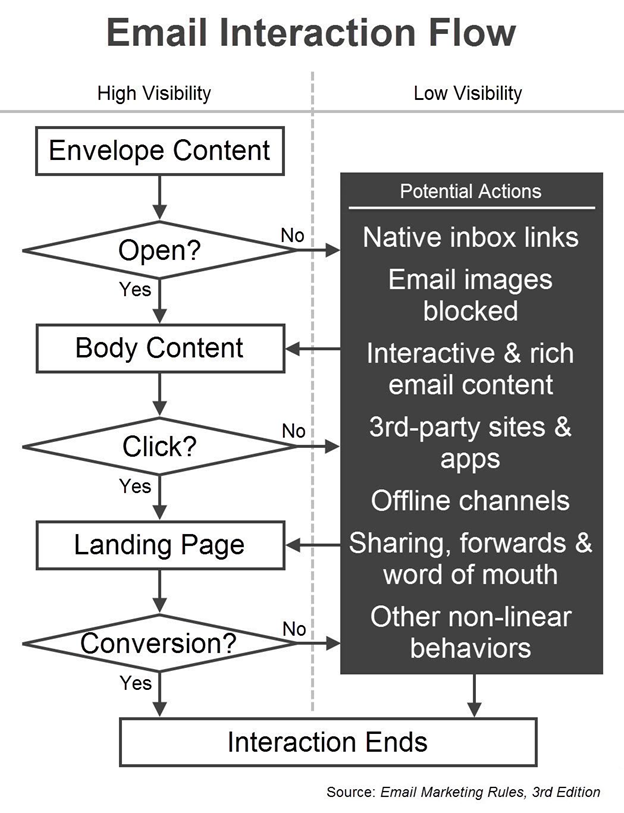Apple’s MPP May Drive Email Design Changes that Actually Hurt Customer Engagement
Apple’s Mail Privacy Protection will have a broad range of effects on email marketers, impacting email analytics, design, deliverability, personalization, and optimization efforts. Sadly, subscribers who enable MPP will receive less relevant emails and more emails than they would have otherwise gotten if marketers could better measure their engagement through opens.
I also fear that Apple’s changes will cause marketers to change their messaging and design strategy to drive clicks more insistently, since opens will be unreliable for a substantial portion of their audience. This move would be understandable. With Apple generating false opens for the users of their Mail app that enable MPP, opens will become a meaningless sign for many subscribers. Marketers will want to compensate for the loss of their highest frequency engagement signal by boosting their second highest frequency engagement signal, clicks, which are currently about one-eighth as frequent as opens.
The adjustments that will be required for reengagement campaigns illustrate what may happen more broadly. For example, before MPP, the goal of a reengagement campaign was to simply get the subscriber to open the email, which would be a signal that the email address was still valid and that a live person was receiving the email. For people who enable MPP, that will be wholly inadequate, since Apple will be generating false opens for every email they receive. That means that marketers will need a stronger signal—a click—in order to be sure that the email address is safe to continue mailing to.
This need for more clicks more often could cause marketers to redesign many other emails, too.
For example, companies may move valuable content from the body of their emails to landing pages in order to coax more clicks out of subscribers. This would reverse years of email design philosophy and send us backsliding toward a time when emails were postcard-style teasers to get people to visit website landing pages.
This would be bad for subscribers and marketers for three interrelated reasons.
Every Step Down the Funnel Equals More Friction
First, each step you ask your subscribers to take adds friction to the interaction, which means they’re less likely to complete it. And that leap from the inbox to a landing page is the biggest source of friction. So, you’re generally going to have more engaged and satisfied subscribers if you can provide them with substantial value before they click through—whether it’s a discount code they can use online or in-store, or a summary of key information from a blog post or article—not only after they click through.
Richer Email Experiences Yield More Qualified Clickers
Second, when you can provide subscribers with more information and more compelling experiences in the inbox, then they’ll convert at higher rates when they do click through. That’s why engagement in the inbox has been a small but growing trend for years. Animation, video in email, CSS-based interactivity, and AMP for Email are all about reducing friction and taking fuller advantage of the click the subscriber gave the brand when they opened the email—rather than demanding yet another click before delivering substantial value. All of those innovations have been great for the subscriber experience and therefore marketers who are focused on brand impact and total conversions.
Subscribers Don’t Always Follow the Golden Path
And third, often the natural tendency of many subscribers is to not follow the Golden Path that we lay out for them. So, while we’d love for people to receive our email, read the envelope content, open the email, read the body content, click through to the landing page, browse our site or app, and then convert, that’s not what happens all the time. Not by a long shot.

For example, a subscriber could get an email, just see the sender name, and hop in their car and go to your store and buy a bunch of stuff. Or they could open up the email and tell their spouse or friend about the content of the email and that person might go to your website and convert. As I point out in my book, Email Marketing Rules, human behavior is messy and it’s often difficult to tie subscriber actions back to the emails that prompted them to act.
The consequence of those three realities is that the more we try to force subscribers to take actions that we can measure rather than delivering value at every interaction step, the less effective and less friendly the subscriber experience becomes. This truth has been painfully evident in the backlash against web publishers who use click-bait headlines and in the high list fatigue experienced by email marketers who use open-bait subject lines. Let’s not repeat failed strategies because of Mail Privacy Protection.
What’s the Solution?
To start, marketers will need to track their Apple Mail users separately and treat them differently. Thankfully, Apple is giving the industry the ability to identify opens from Apple devices generically. It’s not perfect, but the false positive rate will be low.
With fake opens from Apple screened out, you’ll be left with a segment that’s producing real opens. For these subscribers, you can continue to send your existing reengagement campaigns and open-triggered nurture series, for example, and use your existing inactivity suppression rules. This segment can also be used as a proxy for the open behavior of your entire audience, allowing you to better understand overall campaign performance, accurately calculate click-to-open rates, measure email channel health, and more. For example, looking at your real open rate by mailbox provider (i.e., gmail.com, outlook.com) can help you recognize when you might be experiencing blocking or junking.
However, for Apple Mail users, you’ll need to change how you make individual-level decisions about segmentation and suppression, as well as open-triggered series progressions. For the latter, marketers will likely just need to move to date-triggered series with messaging in subject lines and body content that reinforce the sequential, serialized nature of these communications. The former issue of segmentation and suppression is a bit more complicated.
To effectively do that, marketers need to take a more holistic view of their subscribers’ behaviors, looking beyond just the email channel to how they act across all channels. In other words, we need to supplement email behaviors with customer behaviors (i.e., app, web, and offline behaviors) to guide how we treat them as email subscribers.
There’s already precedence for this in how lots of companies treat long-term inactives. For example, if you have two chronically inactive subscribers and one is an active customer and the other isn’t, then mindful companies will continue to mail the active customer but suppress the non-customer. It’s a calculated risk to continue to mail that customer. Even though their apparent inactivity may reduce your email engagement slightly, you’re banking on the continued influence of your emails’ sender name, subject lines, and preview text on the customer’s offline behaviors. It’s a smart bet.
Merging Subscriber & Customer Behaviors
The challenge now is for brands to increase their visibility into their email programs’ influence on subscribers outside of the email channel. Today, you can get a general read on this influence by, for instance, looking at the overall revenue from or retention rate of your customers who are email subscribers versus your customers who aren’t. That differential tells you about both the easy-to-measure direct influence of your email campaigns and the hard-to-measure indirect influence of them.
But the changes by Apple will make individual-level data necessary, since that’s the level that segmentation and suppression decisions are made. This data should include first-party data from your email, web, social, app, call center, events, and other channels, as well as zero-party data from your preference center and progressive profiling efforts. The bigger challenge for many brands will be mobilizing all of this data in one place to create a single view of the customer that they can act on in real-time.
For a long time, email marketers have over-valued and over-relied on easy-to-measure email metrics like opens. Rather than degrading the email experience to force our subscribers to give us clearer email marketing signals in the form of clicks, let’s make better use of the omnichannel signals that they’re already giving us.
Chad will be leading a discussion on this article on the OI-Members-Only Live Zoom on Thursday, September 9, from 12:00 Noon to 1:00 PM ET. Members, watch the dsicussion list for an invite and a link. Not a member? We have a few spots available for guests -- reach out to Jeanne Jennings to request one.
 Photo by Bernd Dittrich on Unsplash
Photo by Bernd Dittrich on Unsplash

 How to resolve AdBlock issue?
How to resolve AdBlock issue? 
